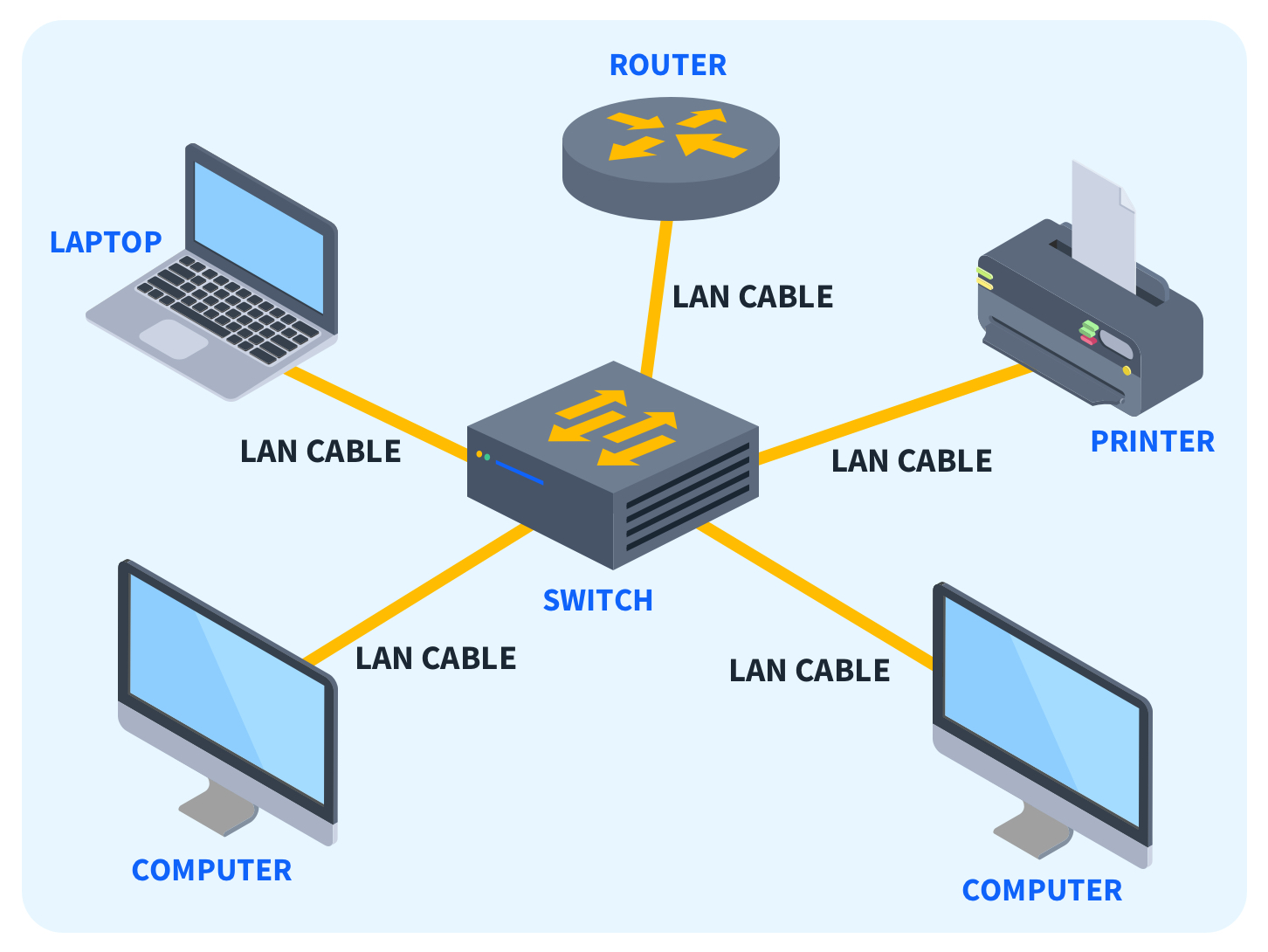
LAN Networking Essentials: Understanding Local Area Networks

**Local Area Network (LAN)** technology is a crucial aspect of modern networking, enabling effective communication and resource sharing among devices within a limited geographical area. As businesses and individuals increasingly rely on digital connectivity, understanding LAN networking is essential. This article, titled "LAN Networking Essentials: Understanding Local Area Networks," aims to provide an extensive overview of the foundational elements of LANs, their benefits, and the technologies involved.
In today's fast-paced world, knowledge of the various components, configurations, and protocols associated with LAN net settings is invaluable. This article will cover everything from the basic definition of a local area network to the future trends shaping LAN technology. By the end of this comprehensive guide, readers will equip themselves with the necessary skills to navigate and optimize their own LAN networking environments.
- What is a Local Area Network (LAN)?
- The Purpose and Benefits of LANs
- Common Components of a LAN
- Understanding LAN Protocols
- Wired vs. Wireless LANs
- Topologies in LAN Networking
- Setting Up a Local Area Network
- Troubleshooting Common LAN Issues
- Security Measures for LANs
- Future Trends in LAN Technology
- Conclusion
What is a Local Area Network (LAN)?
A **Local Area Network (LAN)** refers to a system of interconnected computers and devices within a limited area, such as a home, school, or office building. Unlike wide area networks (WANs), which span larger geographical distances, LANs focus on smaller, localized environments. The primary function of a LAN is to facilitate resource sharing among connected devices, allowing users to access files, printers, and other resources seamlessly.
In essence, a LAN comprises multiple devices that communicate via a common communication medium. These devices include personal computers, laptops, printers, servers, and network-attached storage (NAS) systems. By employing various LAN networking technologies, users can collaborate and efficiently share information without the need for external internet connections.
The Purpose and Benefits of LANs
The primary purpose of establishing a **Local Area Network** is to enable resource sharing among users. This can encompass files, applications, and devices, ultimately promoting collaboration and productivity. For example, employees in an office can easily share documents while accessing a centralized printer, thereby streamlining daily operations.
Beyond collaboration, there are several benefits associated with utilizing a LAN:
- Cost Effectiveness: LANs reduce the need for multiple devices and storage solutions, as users can access common resources without duplication.
- Centralized Data Management: A LAN allows for centralized management of data and applications, making it simpler to back up files or maintain software.
- Enhanced Communication: LANs enable quick communication between users through instant messaging and file sharing, significantly enhancing teamwork.
- Network Security: By controlling access to resources, administrators can implement security measures that protect sensitive information.
Common Components of a LAN
A **LAN** is composed of various essential components that work in tandem to provide effective connectivity and resource sharing. Some common components include:
- Network Switches: These devices connect multiple computers within the LAN and direct data packets efficiently between them.
- Routers: Routers serve as gateways, connecting the LAN to the internet or other networks. They facilitate communication between devices on the LAN and external networks.
- Access Points: For wireless LANs, access points allow devices to connect to the network wirelessly, expanding connectivity options.
- Cabling: Wired LANs utilize Ethernet cables to connect devices, ensuring reliable and fast data transmission.
- Network Interface Cards (NICs): Each device on a LAN requires a NIC to connect to the network, whether wired or wirelessly.
Understanding LAN Protocols
LANs operate on various **network protocols** that define the rules for communication among devices. These protocols ensure that data is efficiently transmitted and received without errors. Among the most significant protocols used in LAN networking are:
- Ethernet: This is the most commonly used protocol for wired LANs. Ethernet frames facilitate the transmission of data across the network.
- Wi-Fi (IEEE 802.11): This protocol allows for wireless communication between devices in a LAN setting, enabling mobility and flexibility.
- TCP/IP: This suite of protocols is essential for data transmission over the internet and is commonly used in LANs to manage network traffic.
Wired vs. Wireless LANs
When setting up a LAN, one crucial decision involves choosing between a **wired** or **wireless** configuration. Each method has its advantages and drawbacks, impacting performance, cost, and ease of setup.
Wired LANs
Wired LANs utilize physical cabling, such as Ethernet cables, to connect devices. This method typically offers several advantages:
- Reliability: Wired connections generally provide more stable and consistent speeds compared to wireless.
- Speed: Wired LANs can support higher bandwidth, enabling faster data transfer rates.
- Security: Physical connections are more secure, as unauthorized access is more challenging compared to wireless networks.
Wireless LANs
Wireless LANs, or Wi-Fi networks, allow devices to connect without physical cables. While these setups provide greater flexibility and mobility, they also present some challenges:
- Interference: Wireless networks can be susceptible to interference from other electronic devices, affecting performance.
- Security Vulnerabilities: Wireless connections may have weaker security, making them more susceptible to unauthorized access if not properly configured.
- Speed Limitations: The speed of wireless connections may vary due to distance from the access point and surrounding obstacles.
Topologies in LAN Networking
The structure of a **LAN** is often defined by its **topology**, which describes how devices are connected and how data flows throughout the network. Common LAN topologies include:
- Bus Topology: Devices are connected to a single central cable, or bus. While easy to set up, this configuration can suffer from performance issues if too many devices are connected.
- Star Topology: Connected to a central hub or switch, star topologies offer high performance and stability. If one device fails, it does not affect the entire network.
- Ring Topology: Each device is connected in a circular manner. If one device fails, it can disrupt communication across the entire network.
Setting Up a Local Area Network
Establishing a **LAN** involves several steps, whether for home or business use. A general setup process includes:
- Determine Network Requirements: Assess the number of devices, required bandwidth, and deployment options (wired or wireless).
- Choose the Appropriate Hardware: Depending on the requirements, select switches, routers, access points, and cables.
- Install Hardware: Set up and connect the network components as needed.
- Configure Network Settings: Assign IP addresses and configure settings for devices and servers to ensure seamless communication.
- Test the Network: Verify connectivity, speeds, and functionality by troubleshooting any performance issues.
Troubleshooting Common LAN Issues
With any **LAN**, issues may arise, necessitating troubleshooting. Common problems include:
- Connectivity Issues: Ensure that all cables are properly connected and that devices are powered on.
- Slow Performance: Analyze network traffic; too many devices or high bandwidth usage can lead to slower speeds.
- Access Problems: Users may encounter difficulties accessing shared resources; verify permissions and configurations.
Security Measures for LANs
Maintaining security in a **LAN** is critical, as it protects sensitive data and user information. Essential security measures include:
- Network Segmentation: Divide the LAN into various segments to improve security and performance.
- Access Control: Implement user permissions and employ strong passwords to restrict unauthorized access.
- Regular Updates: Keep network devices and software updated to mitigate vulnerabilities.
- Use of Firewalls: Deploy firewalls to monitor and control incoming and outgoing network traffic.
Future Trends in LAN Technology
As technology continues to evolve, several trends are expected to shape the future of **LAN networking**:
- Increased Adoption of Wi-Fi 6: The latest Wi-Fi standard promises faster data rates and reduced congestion, enhancing wireless LAN capabilities.
- IoT Integration: The growing prevalence of Internet of Things (IoT) devices will necessitate more robust LAN configurations.
- Enhanced Security Protocols: With evolving cyber threats, improved security architectures and protocols will become increasingly essential.
Conclusion
Understanding **Local Area Networks** is fundamental for both personal and professional environments. As outlined in this comprehensive guide, LAN networking facilitates effective communication, resource sharing, and collaboration among users. From selecting the right components to implementing security measures, there are numerous factors to consider. By leveraging the information shared here, individuals and organizations can optimize their LAN setups for peak performance, security, and future scalability.
As technology continues to advance, staying informed about updates in LAN net systems and emerging trends will empower users to make informed decisions in their networking endeavors. Whether establishing a home network or managing a corporate LAN, knowledge of essential principles will set the stage for successful connectivity and resource sharing.
Did you find this article helpful? LAN Networking Essentials: Understanding Local Area Networks See more here Education.
Leave a Reply






Related posts